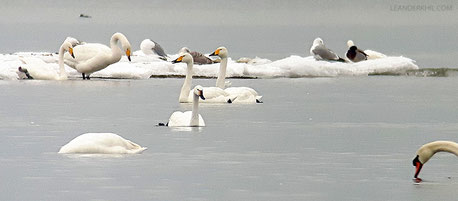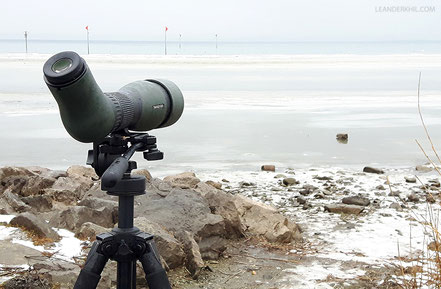Birding directions: Rhine Delta
This page gives a short overview on where to watch birds in one of the best birding sites Austria has to offer: The Rheindelta (Rhine Delta) in the westernmost state of Vorarlberg, on the shores of Bodensee (Lake Constance). The area is best known for records of extreme vagrants, high numbers of migrating and wintering waterbirds and some endangered breeding species.
The name Rheindelta - in the broadest birding sense - comprises various wetlands, mudflats, grassland, reeds, alluvial forests and shore protection structures between the border to Switzerland in the west and the mouth of river Bregenzer Ach, close to the state's capital Bregenz, in the east. The central part of the area is formed by the mouth of river Rhein ("Rheinmündung") and its two dykes, which are directing the water and rubble of the river far into the lake.
All described spots are connected by bikeways and can be explored easily this way if you stay in Hard, Fußach or at the Rohrspitz campsite. Bike routes (in German) are described in the birding app of Hotel am See in Hard.
Be sure to use these descriptions as guidelines only and explore the area yourself. There are plenty of other places that can attract good birds around the year.
Best time to visit: January-May / September-January.
During the summer months, many places along the lake are crowded with tourists. In winter, these sites are much less attractive in case of ice covering.
More information: Naturschutzgebiet Rheindelta (German) | rheindelta.com (German) | Birdforum
Current observations: ornitho.at | ornitho.ch
(1) Rheinmündung: Linker Rheindamm
The left (western) dyke of river Rhine can be visited on foot or by bike. Park at the base of the dyke here and walk out on or on
the path next to it. Depending on the water level of the lake, there can be sandbanks in the river. Check out the bushes, patches of reed, trees and areas of gravel - surprises have turned up
everywhere.
After about one kilometer, you see Lagune on the left. This lagoon (a major breeding site for Common Terns and Black-headed Gulls and sometimes Mediterranean Gull) is separated from the lake by
another gravel dam and can thus be walked around. The reeds along Lagune host Little Bittern. At the tip of the dyke, try some "seawatching" for skuas, divers and terns - depending on the season.
(2) Rheinmündung: Rechter Damm
Similar to Linker Rheindamm, park here and walk or cycle out the dyke. At the beginning, to your right, vast areas of reed (Schleienlöcher) attract different species as the dykes themselves. In winter, Aythya ducks and sometimes scoters can be seen to the right of the dam. Some Eiders usually spend summer and winter in this part.
(3) Fußacher Bucht
The bay to the west of the mouth of river Rhine can be viewed from the left dyke, as well as from a hide on the reed-covered south shore. The hide can only be accessed by bike or on foot, you can drive up to here. When going there, be sure to check out the meadows to the south and the area around the pumping station. Depending on water levels (or ice covering in winter) and season, this can be a feeding site for thousands of ducks.
(4) Harder Binnenbecken and Grüner Damm
Park at the south shore of Harder Binnenbecken, an artifical bay worth a visit especially in winter, when it can attract large numbers of gulls and other waterfowl. From here you can walk/cycle around the bay up to Grüner Damm, the dyke isolating it from the lake, to check for rafts of diving ducks, grebes or divers.

(5) Bregenzer Ach-Mündung
The mouth of river Bregenzer Ach includes large sand banks that can be attractive as a roost for gulls, cormorants and odd surprises. Drive up to Landesfischereizentrum and park along the access road. Continue a few more meters along the road, past the building and turn right on one of the paths, leading to the lookout point.
(6) Fußacher Ried and Höchster Ried
North-west of Fußach, large meadows stretch along the levee. Parts of this area can be seen when visiting other spots (like Glashaus or Fußacher Bucht) but it can be well worth to separately explore these meadowlands.

(7) Rohrspitz/Glashaus
Drive to Glashaus, a restaurant at the lake's shoreline. The view out to the lake can be very rewarding for birdwatchers. A small island usually hosts roosting waterbirds. When the water levels are low, the island is no longer an island, but large mudflats appear that attract waders. In winter, this is one of the best places to see Whooper and the much rarer Bewick's Swans, as well as other waterbirds (usually distant). From the restaurant, it's possible to continue to the east along Fußacher Bucht (on foot or by bike). First past the campsite, then on the levee. Eventually you reach the hide of Fußacher Bucht and the pumping station described in (3).
